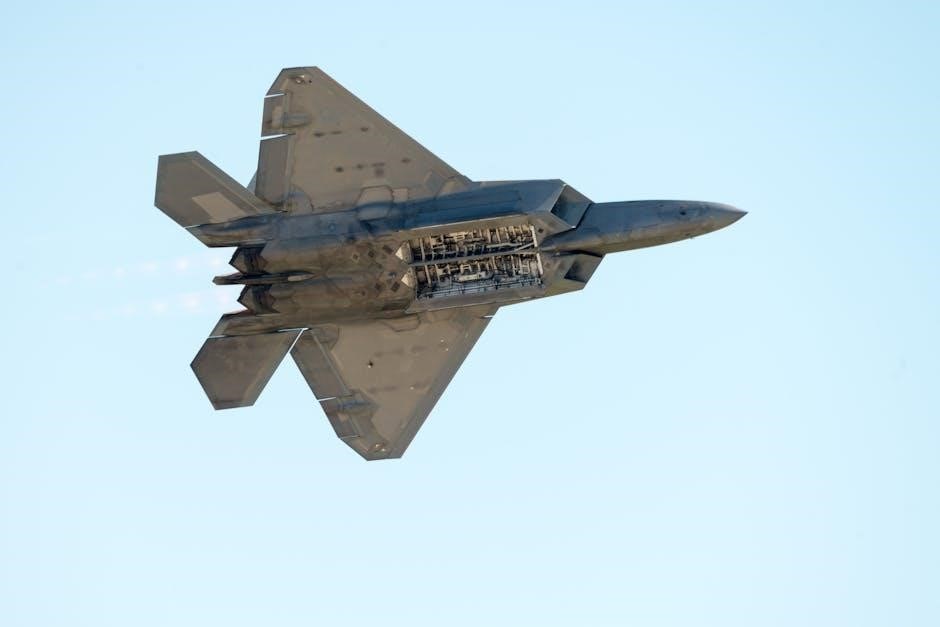F-22 Flight Manual: A Comprehensive Overview (as of 11/25/2025)
This manual, dated November 25, 2025, details the F-22 Raptor’s operation, spanning over 550 pages, covering safety, flight procedures, and maintenance for pilots.
It’s a critical resource for understanding this advanced air superiority fighter, including hypoxia concerns and new helmet testing.
The Lockheed Martin/Boeing F-22 Raptor stands as a pinnacle of modern air superiority, a twin-engine, supersonic stealth fighter representing a significant leap in aviation technology. This aircraft is renowned for its exceptional speed, agility, and, crucially, its stealth capabilities, making it a dominant force in aerial combat scenarios.
Piloted by highly trained aviators like Major Samuel Larson, the F-22 isn’t merely a machine; it’s a complex system demanding comprehensive understanding. This manual serves as the definitive guide for all personnel involved in its operation and maintenance. It details everything from pre-flight checks to emergency procedures, ensuring safe and effective utilization of the Raptor’s immense potential.
Understanding the F-22 requires acknowledging its advanced systems, including sophisticated avionics and a cutting-edge flight control system. This document provides the necessary knowledge to navigate these complexities, empowering pilots to confidently execute missions and maintain operational readiness.
Historical Development and Purpose
The F-22 Raptor’s genesis lies in the Advanced Tactical Fighter (ATF) program of the 1980s, born from the need to counter emerging Soviet air threats. Initial concepts evolved through rigorous testing and refinement, culminating in the first flight of the YF-22 prototype in 1997. This marked a pivotal moment in the development of fifth-generation fighter technology.
Its primary purpose is to establish and maintain air superiority, ensuring control of the skies in any conflict zone. The Raptor’s stealth characteristics, combined with its advanced sensors and weaponry, allow it to penetrate enemy airspace undetected and neutralize threats effectively.
The F-22’s development wasn’t without challenges, including cost overruns and technical hurdles. However, its capabilities ultimately justified the investment, solidifying its position as a cornerstone of the U.S. Air Force’s combat air power. This manual reflects decades of operational experience and continuous improvement.
Key Features and Capabilities
The F-22 Raptor distinguishes itself through a unique blend of stealth, speed, and agility, establishing it as a dominant air superiority fighter. Its defining characteristic is its low observable technology, minimizing radar cross-section and enhancing survivability. Coupled with its twin Pratt & Whitney F119 engines, the Raptor achieves supercruise – sustained supersonic flight without afterburners.
Beyond its physical attributes, the F-22 boasts advanced avionics and sensor fusion, providing pilots with unparalleled situational awareness. This includes sophisticated radar systems and electronic warfare capabilities. The aircraft’s maneuverability is exceptional, enabling it to outmaneuver most adversaries in close-quarters combat.
Major Samuel Larson exemplifies the Raptor’s capabilities through daring flight demonstrations, showcasing its performance envelope. The F-22’s integrated systems and pilot interface contribute to its overall effectiveness, making it a formidable force in modern aerial warfare.
Aircraft Systems
This section details the F-22’s complex systems, including propulsion, stealth technology, avionics, and the flight control system – essential for safe operation.
Engine and Propulsion Systems
The F-22 Raptor is powered by two Pratt & Whitney F119-PW-100 turbofan engines, providing exceptional thrust and enabling supercruise capability – sustained supersonic flight without afterburners. These engines incorporate advanced technologies for enhanced performance and reduced detectability.
Key features include thrust vectoring nozzles, allowing for precise control and maneuverability during flight. The propulsion system is meticulously designed for optimal efficiency and reliability, undergoing rigorous testing and maintenance procedures.
Understanding the engine’s operational parameters, including temperature and pressure limits, is crucial for pilots. Regular inspections and adherence to maintenance schedules are paramount to ensure continued safe and effective operation of the F-22’s powerful propulsion system. The manual provides detailed guidance on engine management and troubleshooting.

Stealth Technology and Radar Cross-Section Reduction
The F-22 Raptor’s stealth capabilities are paramount to its operational effectiveness, achieved through a combination of design features and materials. The aircraft’s shape, incorporating faceted surfaces and internal weapons bays, minimizes radar reflections.
Radar-absorbent materials (RAM) further reduce the aircraft’s radar cross-section (RCS), making it significantly harder to detect by enemy radar systems. Maintaining the integrity of these materials is critical, and the flight manual details specific procedures for handling and inspection.
Pilots must adhere to strict protocols regarding external stores and configurations, as even minor deviations can compromise stealth characteristics. Understanding the principles of RCS reduction and the limitations of stealth technology is essential for maximizing the F-22’s survivability in contested airspace.
Avionics and Sensor Suite
The F-22 Raptor boasts a highly integrated avionics and sensor suite, providing pilots with unparalleled situational awareness. This suite includes advanced radar systems, electronic warfare capabilities, and data links, all managed through a sophisticated central computer.
The flight manual dedicates significant sections to understanding the functionality and limitations of each sensor, emphasizing proper employment for optimal performance. Pilots learn to interpret data from various sources, fusing information to create a comprehensive battlefield picture.
Despite lacking a helmet-mounted sight or display, the F-22’s avionics provide extensive support. The manual details procedures for utilizing the aircraft’s other systems to compensate, ensuring pilots can effectively engage targets and navigate complex environments.

Radar Systems Overview
The F-22 Raptor’s AN/APG-77 Active Electronically Scanned Array (AESA) radar is a cornerstone of its capabilities, detailed extensively within the flight manual. This system provides pilots with long-range detection, tracking, and identification of airborne threats.
The manual outlines various radar modes, including air-to-air, air-to-ground, and electronic warfare, explaining their optimal use in different scenarios. Pilots learn to interpret radar returns, differentiate between targets, and employ techniques to counter enemy radar systems.
Emphasis is placed on understanding the radar’s limitations, such as susceptibility to jamming and the impact of terrain masking. The flight manual provides procedures for mitigating these challenges, ensuring pilots maintain situational awareness even in contested environments.
Electronic Warfare Capabilities
The F-22 Raptor’s electronic warfare (EW) suite, thoroughly documented in the flight manual, is designed to disrupt enemy radar and communication systems while protecting the aircraft from similar attacks. This includes advanced jamming capabilities and electronic countermeasures (ECM).
Pilots are trained to utilize the EW suite defensively, employing techniques to suppress enemy air defenses and enhance survivability. The manual details procedures for identifying and responding to various electronic threats, ensuring pilots can maintain operational effectiveness in a contested electromagnetic spectrum.
Furthermore, the F-22 can also conduct offensive EW operations, disrupting enemy command and control networks. The flight manual provides guidance on the ethical and tactical considerations of employing these capabilities, emphasizing responsible use of electronic warfare.
Flight Control System
The F-22 Raptor’s flight control system, extensively detailed within the flight manual, is a fly-by-wire system offering exceptional maneuverability and responsiveness. It utilizes a highly sophisticated computer to interpret pilot inputs and control the aircraft’s surfaces, enabling precise control even at extreme angles of attack.
The manual emphasizes the system’s stability augmentation features, which prevent the aircraft from entering dangerous flight regimes. Pilots receive comprehensive training on the system’s characteristics and limitations, including procedures for handling potential malfunctions.
Detailed diagrams and explanations within the manual illustrate the system’s architecture and operation, covering everything from control stick inputs to actuator responses. Understanding this system is paramount for safe and effective F-22 operation, as outlined in the current RTM.

Operational Procedures
The flight manual meticulously outlines pre-flight checks, taxiing, takeoff, in-flight maneuvers, and landing procedures, ensuring safe and effective F-22 operation.
Pre-Flight Inspection Checklist

The F-22 Raptor pre-flight inspection is a comprehensive, multi-stage process detailed within the flight manual, prioritizing safety and mission readiness. It begins with a thorough visual examination of the airframe for any structural damage, including control surfaces and stealth coatings.
Next, pilots meticulously check all fluid levels – hydraulic, oil, and coolant – verifying they are within acceptable parameters. Avionics systems undergo rigorous testing, encompassing radar functionality, electronic warfare suites, and communication systems.

Engine inspections involve verifying proper nozzle alignment and checking for fuel leaks. Flight control surfaces are moved through their full range of motion to ensure responsiveness. Finally, the oxygen system is tested, a critical step given reported hypoxia-like symptoms experienced by both pilots and ground crews.
Reference the current Revision Technical Manual (RTM) for detailed, step-by-step instructions, as procedures are subject to updates and revisions.
Taxiing and Takeoff Procedures
The F-22 Raptor’s taxiing procedures emphasize maintaining situational awareness and adhering to strict ground control instructions. Pilots utilize differential thrust and precise steering to navigate the airfield, mindful of the aircraft’s wide turning radius. Before takeoff, a final systems check is performed, confirming all parameters are nominal.
Takeoff is typically initiated using full afterburners, achieving rapid acceleration and a steep climb angle. Pilots monitor engine performance closely during this critical phase, adhering to prescribed climb gradients and airspeed targets.
The flight manual details specific procedures for various runway conditions and wind scenarios. It also outlines emergency abort procedures, should any anomalies arise during the takeoff roll. Following a successful liftoff, pilots transition to a climb configuration, retracting landing gear and initiating a pre-planned route.
Pilots must reference the current RTM for detailed instructions, as procedures are subject to change.
In-Flight Operations
The F-22 Raptor’s in-flight operations are characterized by a blend of advanced avionics utilization and precise flight control. Pilots leverage the aircraft’s sensor suite for situational awareness, constantly scanning for potential threats and maintaining communication with command and control.
Normal flight maneuvers are executed with a focus on energy management and aerodynamic efficiency. The manual details procedures for maintaining optimal airspeed, altitude, and angle of attack, maximizing the aircraft’s performance envelope.
Air-to-air combat tactics emphasize exploiting the F-22’s stealth capabilities and superior maneuverability. Pilots are trained to engage adversaries at long range, utilizing beyond-visual-range missiles and employing defensive maneuvers to evade enemy fire.
The flight manual provides detailed guidance on various combat scenarios, including one-versus-one engagements, multi-ship tactics, and defensive counter-air operations.
Normal Flight Maneuvers
Executing normal flight maneuvers in the F-22 Raptor demands precise control and a thorough understanding of aerodynamic principles. The flight manual meticulously outlines procedures for level flight, climbs, descents, and turns, emphasizing energy management throughout each phase.
Maintaining optimal airspeed is crucial, with specific recommendations provided for various altitudes and configurations. Pilots learn to utilize the throttle and flight controls to achieve and sustain desired speeds efficiently.
Turns are performed using coordinated aileron and rudder inputs, minimizing adverse yaw and maximizing roll rate. The manual details proper bank angles and turn radii for different flight conditions.
Climbs and descents are executed with a focus on maintaining a stable rate of climb or descent, while carefully monitoring engine parameters and airspeed. Pilots are trained to anticipate and correct for any deviations from the desired flight path.
Air-to-Air Combat Tactics
The F-22 Raptor flight manual dedicates significant sections to air-to-air combat tactics, recognizing its primary role as an air superiority fighter. These tactics emphasize leveraging the aircraft’s stealth, speed, and maneuverability to gain a decisive advantage over adversaries.
Initial engagement strategies focus on exploiting the F-22’s beyond-visual-range (BVR) capabilities, utilizing its advanced radar and missile systems to detect, identify, and engage enemy aircraft at extended ranges.
Should combat escalate to within-visual-range (WVR) engagements, pilots are trained in aggressive maneuvering techniques, including high-aspect attacks and defensive maneuvers to evade enemy missiles and gunfire.
The manual stresses the importance of situational awareness, utilizing the aircraft’s sensor fusion capabilities to maintain a comprehensive understanding of the battlespace and anticipate enemy actions. Pilots like Major Samuel Larson exemplify these daring displays.
Landing Procedures
The F-22 Raptor flight manual outlines precise landing procedures, emphasizing safety and precision due to the aircraft’s high performance characteristics. Approach speeds are carefully calculated based on weight, wind conditions, and runway length, demanding meticulous pilot attention.
The manual details the use of the aircraft’s advanced flight control system to maintain stable approaches and execute smooth touchdowns. Pilots are instructed on proper flap and landing gear deployment sequences, as well as the use of automatic landing systems when appropriate.
Post-touchdown procedures cover braking techniques, including the use of parachutes and wheel brakes to decelerate rapidly. Reference the current Revision Technical Manual (RTM) for detailed instructions.
Taxiing procedures are also covered, emphasizing careful maneuvering to avoid obstacles and maintain control of the aircraft on the ground. Safety is paramount, with specific guidelines regarding children on the flight line.

Pilot Life Support
This section details critical systems, including oxygen for hypoxia prevention, advanced flight helmets undergoing testing, and anti-G suits for physiological training.
Oxygen Systems and Hypoxia Concerns
The F-22 Raptor’s oxygen system is paramount for pilot safety, particularly at high altitudes where hypoxia poses a significant threat. Reports indicate that both F-22 pilots and ground crews have experienced hypoxia-like symptoms, prompting ongoing investigation into the root cause.
The aircraft utilizes a complex oxygen delivery system, designed to provide 100% oxygen on demand. Pilots are rigorously trained to recognize the symptoms of hypoxia – including dizziness, confusion, and visual disturbances – and to immediately activate the emergency oxygen supply.
Current research focuses on identifying potential contaminants or malfunctions within the oxygen concentration system. The Air Force is actively testing and implementing improvements to ensure a reliable and safe oxygen supply for all F-22 flight operations. Regular maintenance and thorough system checks are crucial preventative measures.
Flight Helmet and Vision Systems
The F-22 Raptor’s flight helmet is a critical component of the pilot’s situational awareness, undergoing continuous testing and development to meet evolving operational needs. Currently, the U.S. Air Force is evaluating a new helmet design, directly incorporating feedback from pilots regarding usability and performance.
Interestingly, Lockheed Martin has confirmed there are no current plans to integrate a helmet-mounted sight or display system into the F-22A Raptor. The rationale centers on the aircraft’s existing, highly capable avionics and sensor suite, which provide comprehensive information without relying on helmet-mounted technology.
However, the focus remains on optimizing the current helmet’s comfort, weight, and integration with the pilot’s oxygen system and communication equipment. These improvements aim to enhance pilot performance and reduce fatigue during extended flight missions, ensuring optimal vision and cognitive function.
Current Helmet Testing and Development
Recent evaluations center on a new helmet design, born directly from pilot feedback, aiming to address previous shortcomings and enhance overall operational effectiveness. Testing protocols rigorously assess the helmet’s structural integrity, impact resistance, and compatibility with the F-22’s life support systems.
A key focus is improving the helmet’s weight distribution and reducing pressure points, minimizing pilot fatigue during long-duration flights. Simultaneously, engineers are refining the visor’s optical clarity and field of view, maximizing situational awareness in all weather conditions.
Furthermore, the development process incorporates advanced materials and manufacturing techniques, striving for a helmet that is both lightweight and exceptionally durable. Data collected during flight tests informs iterative design improvements, ensuring the final product meets the stringent demands of F-22 operations.
Anti-G Suit and Physiological Training
The F-22 Raptor’s extreme maneuverability necessitates comprehensive anti-G training for all pilots. This training focuses on techniques to mitigate the physiological stresses of high-acceleration flight, preventing G-induced Loss of Consciousness (G-LOC). Pilots undergo rigorous centrifuge training, progressively increasing G-forces while practicing anti-G straining maneuvers.
The standard anti-G suit is a crucial component, providing inflatable bladders that counteract the pooling of blood in the lower extremities. Proper suit fitting and maintenance are emphasized, ensuring optimal performance during flight. Training extends beyond physical techniques, encompassing breathing control, muscle tensing, and mental preparedness.
Pilots also receive extensive education on recognizing the early symptoms of G-force stress, enabling proactive intervention before G-LOC occurs. This holistic approach to physiological training is paramount for maintaining pilot safety and combat effectiveness in the demanding F-22 environment.

Maintenance and Safety
This section details routine checks, troubleshooting, emergency protocols, and the availability of updated manuals, ensuring safe F-22 operation and long-term reliability.
Routine Maintenance Schedules
The F-22 Raptor’s operational readiness hinges on a meticulously planned and strictly adhered-to routine maintenance schedule. These schedules are categorized by flight hours, calendar time, and specific operational demands, ensuring all critical systems remain within optimal performance parameters. Inspections encompass a comprehensive review of the aircraft’s structure, engines, avionics, and flight control systems.
Detailed checklists, outlined in the full flight manual (spanning over 550 pages), guide technicians through each step, emphasizing preventative measures to mitigate potential issues before they escalate. Lubrication, fluid level checks, and component replacements are performed at prescribed intervals. Furthermore, the manual details specific procedures for lithium polymer (LiPo) battery safety, including charging instructions and precautions.

Adherence to these schedules is paramount, as deviations can compromise the aircraft’s stealth capabilities, maneuverability, and overall safety. Regular updates to the maintenance schedules are distributed via official channels, reflecting lessons learned from operational experience and ongoing system refinements.
Troubleshooting Common Issues
The F-22 Raptor’s complex systems necessitate a robust troubleshooting section within the flight manual. This section details procedures for diagnosing and resolving frequently encountered issues, ranging from minor avionics glitches to more significant engine performance anomalies. Technicians are guided through a systematic process of symptom identification, fault isolation, and corrective action implementation.
The manual emphasizes the importance of referencing the latest Revision Technical Manual (RTM) for detailed instructions, as procedures are continually updated based on operational feedback. Common issues addressed include intermittent radar malfunctions, electronic warfare suite discrepancies, and flight control system irregularities.
Furthermore, the manual provides guidance on addressing hypoxia-like symptoms experienced by both pilots and ground crews, highlighting the critical need for prompt medical attention. Detailed flowcharts and diagnostic diagrams aid technicians in efficiently pinpointing the root cause of problems, minimizing aircraft downtime and maximizing operational readiness.
Emergency Procedures
The F-22 Raptor flight manual dedicates a substantial section to emergency procedures, outlining step-by-step actions for pilots to take in critical situations. These procedures cover a wide spectrum of scenarios, including engine failure, in-flight fire, loss of flight control, and ejection system activation.
Detailed checklists guide pilots through each emergency, prioritizing immediate actions to ensure aircraft and crew safety. The manual stresses the importance of maintaining situational awareness and adhering to established protocols, even under extreme stress.
Specific attention is given to addressing hypoxia-related emergencies, given the documented instances of oxygen system malfunctions. Procedures for rapid descent, oxygen mask troubleshooting, and emergency landing are thoroughly detailed. The manual also includes guidance on post-emergency procedures, such as damage assessment and reporting, ensuring a comprehensive response to unforeseen events.
Flight Manual Availability and Updates
Access to the official F-22 Raptor flight manual is strictly controlled, primarily limited to authorized personnel within the U.S. Air Force and designated contractors. Currently, a fully up-to-date version (-1) is not publicly available, with even the shortest versions exceeding 550 pages in length.
Updates to the manual are issued regularly, reflecting changes in aircraft systems, operational procedures, and lessons learned from flight operations and incident investigations. These updates are disseminated through official channels, ensuring that pilots and maintenance crews have access to the most current information.

The manual’s revision history is meticulously maintained, documenting all changes and their effective dates. Reference to the current Revision Technical Manual (RTM) is crucial for detailed instructions and adherence to the latest standards.